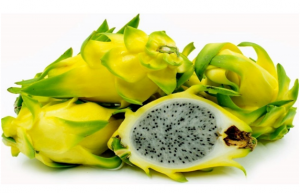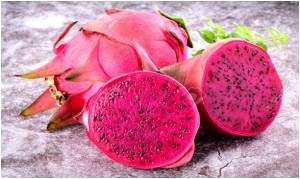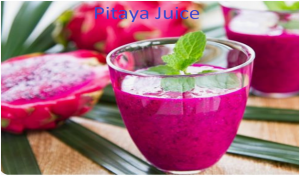Dragon Fruit or Pitaya is one of the rarest tropical natural products you have presumably ever observed and it isn’t unexpected since it has a to some degree unconventional and not in any way average appearance. You may have heard it called pitaya, pitahaya, or mythical serpent natural product, this being the most business name of allIt is typically expended as a new organic product, even though it can likewise be utilized in mixed drinks and soda pops. The yellow is utilized in certain spots as color and the creation of yogurt, frozen yogurt, jams, jams, sodas, and desserts. In certain nations, it is utilized as a color. The red, even though it is progressively boring and less fragrant, is generally utilized as a topping for posts and outlandish mixed drinks. In this article, you have a complete guide with the most intriguing realities about this natural product.
Pitaya, also known as pitahaya or dragon fruit, is a fruit that comes from several species of cactus native to South and Central America. Depending on the type, it can be yellow or deep pink/red (as we saw earlier) and has green leaves. The inside of the fruit is fleshy and contains seeds, like kiwi. Those who try it are often surprised by how mild its flavor is as opposed to its striking appearance. It has a flavor similar to that of melon although it is not as sweet as the latter.
Origin
The origin of the word pitaya or pitahaya comes from the Taíno language, an indigenous language that was spoken in the Antilles, and means “flaky fruit”.
Pitaya was discovered for the first time in Central America, centuries ago in the Mexico area, although today it is present in many corners of the world. In Vietnam, where it is widely cultivated, it is known as thang loy. According to Aztec literature, this fruit has been recorded since the 13th century.
Types of Dragon Fruit (pitaya)
If we look in the supermarkets for pitaya varieties we will see that there is not much, even the vast majority of them do not have this fruit. There are only two types, depending on color, of pitahaya, although there are people who think that there are more like blue pitaya. Say that the red pitaya is available with
-
Yellow Pitaya
The yellow variety: It is prickly, it is cultivated in tropical and high tropical zones, Colombia, Bolivia, Ecuador, Peru, Venezuela, basically Central America. It can be found on the market from January to March. It is about 9 centimeters long and about 7 centimeters wide. It is born green and yellowish when ripe.
-
Red Pitaya
The red variety: It is cultivated in Mexico, Nicaragua, and Vietnam among others. It can be found on the market from June to August. It is 12 centimeters long with a diameter of 8 centimeters. It is characterized by having a red shell, with green bracts that turn yellow when ripe.
Its flavor is delicate and fine, like sugar water, although in our markets, possibly due to the inappropriate conditions of transport, storage, and humidity to which they are subjected, they lose flavor and are somewhat tasteless.
To keep it at home, it is best to stay out of the fridge, in a cool and dry place, away from heat sources and without direct sunlight. We only put it in the fridge for a little while before consuming it. The pitahayas ripe peeled easily, cutting one side of the flower and pulling down. It is cut into slices and you should avoid chewing the seeds.
Properties of the Dragon Fruit or pitahaya
Some of the most outstanding characteristics of pitahaya are that it has a high concentration of vitamin C, minerals, as well as a high fiber content. These nutrients are vital and known throughout the world for their antioxidants, which generally help prevent the formation of free radicals that cause cancer, among other diseases.
If you want more data on dragon fruit, for example, fats, the amount of protein or calories, here is a table where you can find out what the average nutritional composition of this fruit is per 100 grams.
Benefits
The health benefits of dragon fruit are primarily attributed to its antioxidant, antibacterial, and nutritional properties. The benefits include an increase in immunity, body metabolism, and a smoother digestive process. Let’s now look at the benefits in detail:
- High fiber intake: Diets that are high in fiber can help reduce the risks of heart disease, control blood sugar levels, maintain intestinal health and normalize bowel movements, reduce cholesterol levels, and help achieve a healthy weight.
- Iron Source: Carries oxygen to the entire body, which is vital for brain and muscle function.
- Rich in antioxidants: Antioxidants help protect your cells against the effects of free radicals that can cause heart disease, cancer, among others.
- Organic Food: Organic foods are known to have higher levels of antioxidants and nutrients than non-organic foods. They are absorbed much more easily than their conventional equivalents. Organic foods are produced without pesticides or chemicals, which helps not only the environment but also your body.
- Possesses Vitamin C: Vitamin C benefits can include protection against immune system deficiencies, cardiovascular disease, prenatal health problems, eye disease, and even skin wrinkles.
Disadvantages: possible side effects
After having seen the properties section, we all know that this tropical fruit is a good source of minerals and vitamins. To date, no critical side effects have been reported in the consumption of dragon fruit.
It is safe for ingestion, even by nursing and pregnant mothers. However, some of the notable adverse effects of dragon fruit or Pitaya include:
- Change in color of stool and urine: Many nutrition experts recommend their patients suffering from heart disease, asthma, and diabetes to consume pitaya. However, some people have reported that their stool and urine turn red when consumed. However, to date, there is no concrete evidence to support these allegations.
- Harmful to excess health: Excessive consumption of dragon fruit can be detrimental to health. Pitaya seeds are rich in polyunsaturated fats like omega-6 and omega-3 fatty acids. These acids play an important role in minimizing the risk of cardiovascular disorders of sand triglycerides.
It also helps maintain normal body function including removing toxic heavy metals from your body and improving eyesight. Lycopene, the red-colored element found in this tropical fruit, is also associated with reduced risk of prostate cancer.
However, when consumed in excess, pitaya can be a danger to your body’s health because it contains high levels of fructose.
How to know when the Dragon Fruit(pitaya) is ripe
1. Take the pitaya and squeeze it gently. An unripe pitahaya will be firm and hard, while a ripe pitahaya will be slightly softer. Don’t squeeze too hard because you can damage the fruit.
2. Compare the color of this tropical fruit with the rest that is nearby. Ripe dragon fruit will have a richer, more vivid color. Ripe yellow pitaya will have a golden hue, while red pitaya will be brighter red than its less mature counterparts. It should not have discolored spots.
3. Examine it for any mold, wrinkles, bruises, or other signs that may indicate it is too old or damaged. A good fruit must have a consistent body.
How to peel and eat a pitahaya
Dragon fruit is easily cut. The inner pulp can be white or red and both will have small black seeds that are edible.
Peeling the fruit is very simple and it is done very quickly:
1.Wash the fruit and cut it in the center with a knife to separate it into two parts
2. Using a spoon, separate the pulp from the skin (along the edge of the fruit)
3.Ready! You would already have the pulp to eat
Once cut and peeled it’s time to enjoy the dragon fruit. We can eat it ourselves or we can make authentic jewels to eat with our friends, family or as a couple. Imagination to power!
How to make Dragon Fruit juice
Without a doubt, one of the best ways to enjoy the flavor of this fantastic tropical fruit is by preparing a delicious smoothie or pitaya juice. If you have the opportunity to prepare one, do not hesitate. Here we leave you a video that shows you how you can prepare it.
There are white, yellow, and fuchsia colors. Any color they all have very soft black seeds that do not feel when you eat them. Ideal to help a day of detoxification.
Ingredients
- 1 serving
- one pitahaya clean
- 1/2 water drop
Steps 1: Already cleaned and skinless cut into slices.
Steps 2: Take to the blender with the water and blend very well. There is no need to strain.
Steps 3: Enjoy your juice.
Pitaya flower
The pitahaya flower is very peculiar because it is a night flower that only lasts a day. A few days before the flower bud opens, it will experience a spectacular growth that will denote that it is very close to opening. The day the flower opens, the bud wrinkles at the end, however, the flowers do not begin to open until dusk begins. The flower begins to open at the moment when the sun no longer shines directly on the plant. The flowers can also be seen the next morning, but not for long.













